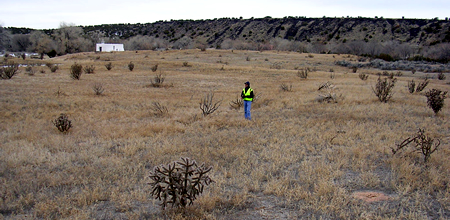
Paa-ko
Galisteo Basin Sites
- Lamy Jct
- Lower Arroyo Hondo Pueblo
- El Camino Real
- Chamisa Locita
- El Crestón
- Espinoso Ridge Pueblo
- La Cienega Pueblo (LA 3)
- La Cienega Pithouse Village
- La Cieneguilla Pueblo (LA 16)
- La Cieneguilla Petroglyphs
- Manzanares Pueblo
- Paa-ko
- Petroglyph Hill
- Pueblo Blanco
- Pueblo Colorado
- Pueblo Galisteo
- Pueblo Largo
- Pueblo San Cristóbal
- Pueblo San Lazaro
- Pueblo Shé
- Rote Chert Quarry
- San José de Las Huertas
- Upper Arroyo Hondo Pueblo
- Pueblo San Marcos
Paa-ko Pueblo, a large Classic Ancestral pueblo and a historic-period pueblo located at the eastern base of the Sandia Mountains, approximately 1 mile north of the town of San Antonio (Bernalillo County).
The pueblo is in a level area just west of San Pedro Creek, which flows northward
about 100 m east of the site. The Ortiz and San Pedro mountains are east of San
Pedro Creek. Paa-ko is within the boundaries  of the San Pedro Grant. San Pedro Creek flows to Tonque Arroyo which enters the Rio Grande at San Felipe Pueblo.
of the San Pedro Grant. San Pedro Creek flows to Tonque Arroyo which enters the Rio Grande at San Felipe Pueblo.
The site is believed to have been occupied from the beginning of the AD 1200s and with a hiatus in the occupation in the AD 1400s. It was finally abandoned during the latter half of the AD 1600s. The earliest known documentation of the ruins came from the research of Adolph Bandelier, who in his 1892 report described portions of mounds that were tall enough for the original buildings to have been more than two stories in height (Lambert 1954:7). Several hundred rooms are buried under rubble mounds. Circular and square kivas are also present, although their exact number still remains unclear.
Paa-ko consists of two roomblocks situated on the south and north sides of an east-northeast flowing drainage. Both roomblocks were partially excavated by N.C. Nelson in 1914. More extensive excavations over 200 rooms were conducted by Edgar Lee Hewett and Marjorie Lambert of the School of American Research in the mid-1930s. Recent research at the site took place through the field school programs at the Northwestern University and the University of Chicago. In the past decade, small cultural resource management projects took place along the NM Highway right-of-way on both sides of Highway 14.
The recovery of Santa Fe Black-on-white, Galisteo Black-on-white, and Wiyo Black-on-white ceramics indicate that Paa-ko was occupied as early as the AD 1200s. The Rio Grande Glazeware ceramics indicate the site was abandoned sometime in the AD 1400s. Lambert suggests that Paa-ko was abandoned due to warfare and cites Athapaskan attacks. The site was later reoccupied after AD 1525 as evidenced by the occurrence of Glaze IV–VI (Glaze D–F) ceramics. The pueblo is important as a way point in the migrations of modern Santa Ana Pueblo.

The earliest rooms at Paa-ko were built of coursed masonry, while the later additions were either stone masonry or a combination of stone masonry and adobe. The pueblo ruins contain several hundred rooms and the historical reoccupation is also spatially extensive. Lycett’s excavation inside the north roomblock revealed the presence of an AD 1600s historic plaza associated with surrounding masonry walls, a wooden corral, and seven superimposed surfaces; the roomblock was also documented by Nelson. Evidence of early metallurgy has been found at the site including lead ore, copper sheet fragments, iron scale within the plaza, and a small smelting feature. A small rubble mound in the central part of the site contains remnants of a structure that served as a NM State Monument Visitors’ Center (1938–1959.
The site is managed and owned by the University of New Mexico.

© New Mexico Office of Archaeological Studies, a division of the New Mexico Department of Cultural Affairs.
The Center for New Mexico Archaeology
7 Old Cochiti Road
Santa Fe, NM 87507
505-476-4404
Fax: 505-476-4448

